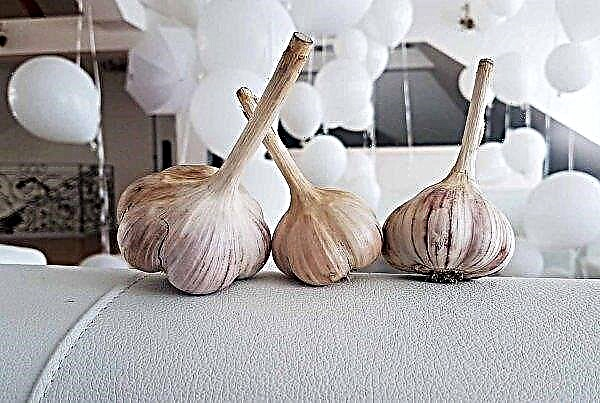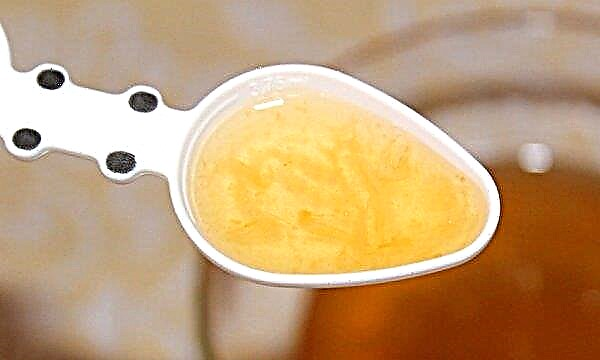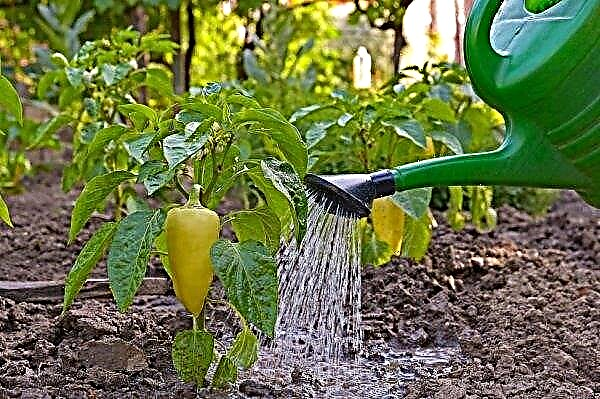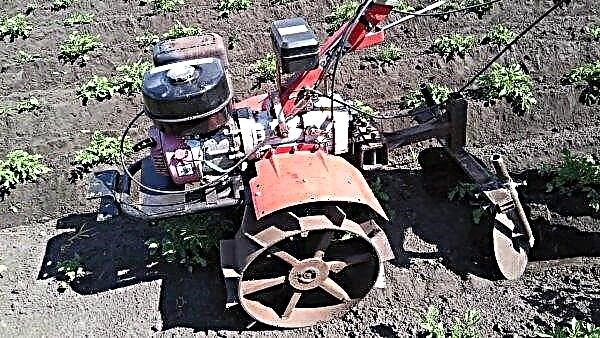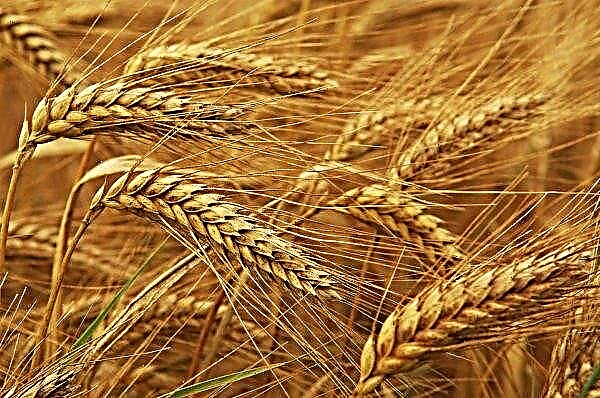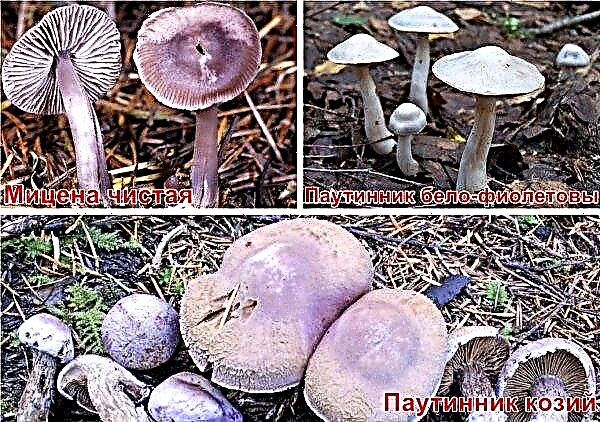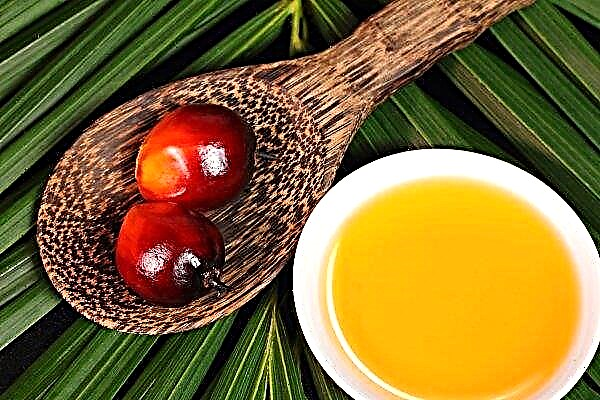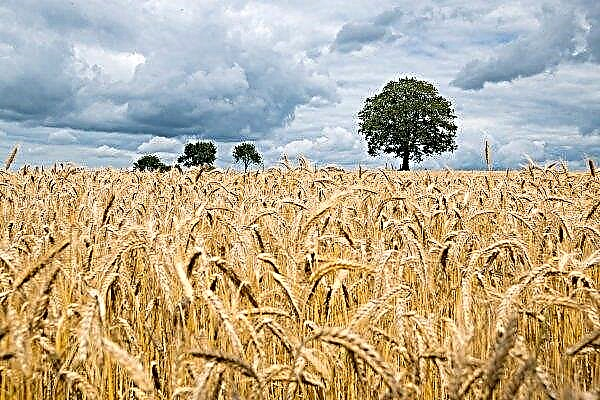In landscape design in recent years, dwarf or stunted plants have increasingly begun to use. Their diversity allows you to create original compositions and form entire natural patterns. Mountain pine Winter Gold is excellent for these purposes. The article will discuss how to properly plant this plant on the site, taking into account all agrotechnical features, as well as how to care for it.
Botanical tree description
Pine Winter Gold belongs to the Pine family and was bred as a new variety only in the second half of the last century in Holland. After that, it spread throughout southern and central Europe. The shrub has a spherical shape and grows only up to 1 m in height. Moreover, in diameter, it can reach 1.5 m.

Pine is developing quite slowly, so the total finished growth does not exceed 4 cm. Crohna Winter Gold is quite dense, with densely spaced shoots. Almost all of them are adjacent to the ground. The plant has a dense bark of gray shade and a well-developed root system.
The needles of the Pinus Winter Gold shrub are quite stiff and short (about 2 cm), with a greenish-yellow tint. In winter, it acquires a bright golden color, which is why the name of the variety is determined. In addition to the needles, small cones of brown color reaching 4 cm in length are also located on the branches.
Landscape design application
Winter Gold is often used in landscape design, acting as a key element in the design of stone gardens or alpine slides. Such solutions are more popular in Asia. As for Central and Eastern Europe, here mountain pine is becoming one of the main elements of classical gardens.

The plant is appreciated for the fact that it occupies a small area and pleases the eye with a bright and saturated color of needles throughout the year. In winter, this culture becomes the main highlight of any regular garden, especially against the background of deciduous trees that have long gone into the resting phase.
Pine can be used as a hedge or a small curb, as well as in group figured compositions. It is worth noting that mixed compositions with mountain pine not only look interesting, but also give the gardener much less trouble, as this coniferous representative has no negative effect on plants located nearby.
Did you know? In China, pine is considered a symbol of long life and happiness. That is why even if the site is too small to plant a tall coniferous plant, the Chinese choose dwarf varieties.
Sometimes mountain pine is planted next to cereal or flowering plants. Separate gardeners have Winter Gold nearby and a decorative maple or heather. Such compositions really look quite impressive, although some difficulties still arise (plants have different requirements for acidity and watering).
Growing regions
The natural habitat of mountain pine is Central and Southern Europe. It develops best in sunny areas with loamy or sandy loamy stony soil. The percentage of soil moisture is not one of the main criteria.
Over time, due to its decorativeness, the bush in question has spread throughout the world. To provide an optimal environment for its development, gardeners recreate all the required conditions listed below on their sites.
Landing
When planting a coniferous plant, the optimal timing should be taken into account: for Winter Gold, this is mid-spring (late April - early May) or early autumn. Particular attention should be paid to the choice of seedlings: it is best to buy specimens aged 3 to 5 years.

Some gardeners prefer replanting young shoots of a plant that they found in the forest or from friends on the site. This option is quite acceptable, but it is necessary to study the external characteristics of the pine: if you see problems with the bark, needles or root system, then it is likely that the plant is infected. Transplanting the process to your site will also result in an infected and weakened specimen.
When purchasing seedlings in specialized stores, it is worth examining their root system carefully. It should be covered with a dense earthen lump. Otherwise, the pine can dry out in the first weeks of development, especially if a sharp change in weather conditions occurs. The percentage of survival of seedlings with an open root system is quite low: 1 out of 4 plants.

To land Winter Gold, you must select the most sunny areas. Penumbra is allowed only for a few hours during the daylight hours. When choosing a place for planting mountain pine, you must also consider that it grows best on soil with a neutral or slightly alkaline reaction. If the soil is too acidic, the pine will be sluggish.
Important! If you plan to plant several seedlings at once in a row or in a checkerboard pattern, it is necessary to maintain a distance of 2-3 m between them. This is necessary so that the plants do not interfere with each other, because the diameter of each of them will be approximately 1.5 m.
When planting mountain pine, it is extremely important to comply with agricultural regulations:
- Initially, it is necessary to weed the area from weeds and only after that dig a planting hole. Most often, a depression of 70 × 70 cm is prepared. Sometimes a slightly larger pit is necessary (depending on the root system and the earth lump on it).
- After this, it is necessary to line a drainage layer up to 25 cm thick at the bottom of the recess. For this, you can use crushed brick, expanded clay, slate or pebbles.
- Now you need to prepare the substrate for planting pine. It is best to mix for this turf soil, sand and peat in a ratio of 2: 1: 1. It is not necessary to additionally use organics, as conifers do not like this.
- When planting shrubs in the planting pit, it is very important to keep the earthen coma as possible. This will affect the speed of adaptation of the plant in a new place.
- After this, you need to carefully fill the air pockets with a substrate, periodically compacting the soil around the seedling with your hands. At the same time, on top of the trunk, you need to sprinkle a thin layer of sand.
- It is worth paying attention that the root neck after planting should remain at a height of 3 cm above the soil level.
- At the end, the plant is watered with 10 liters of water, and when it is absorbed a little, the trunk circle is mulched with sawdust or needles.

Care Rules
Mountain pine is a fairly unpretentious plant, like most conifers. Caring for it boils down to infrequent watering during particularly dry periods, as well as periodic top dressing and loosening of the trunk circle. This undemanding nature makes it possible to plant this shrub in areas even for those gardeners who cannot provide him with regular care, for example, due to lack of time.
Watering
Winter Gold, like many conifers, is drought tolerant. That is why it does not need regular and frequent watering. Additional soil moisture becomes really necessary exclusively in dry weather. Then the pine tree needs to be watered every week (approximately 10-15 liters of water under one bush).
Young seedlings are more capricious and worse tolerate the lack of additional moisture. Instances under the age of 1 year need to be watered 2 times a month, paying attention to the condition of the trunk circle.
 If the weather is too dry and the soil crusts in less than a week, watering should be increased.
If the weather is too dry and the soil crusts in less than a week, watering should be increased.
Sometimes it happens that even after 2 weeks the soil remains wet. In this case, with additional moisture, it is better to wait so as not to provoke stagnation of moisture in the root system and, as a result, its decay.
Top dressing
If the plant has been planted on fertile soil and has successfully reached the age of two, it can be additionally not fed. Only sometimes it is possible to introduce growth stimulants, for example, Speedfol Amino in the amount of 35 g per m².
Mountain pine is a strong and independent plant that copes well without fertilizers. The use of organic additives, on the contrary, can lead to drying out and decay of the needles.
 If we are talking about young seedlings that need additional recharge, they can use mineral complexes, for example, Radifarm in the amount of 25 ml per 10 liters of water.
If we are talking about young seedlings that need additional recharge, they can use mineral complexes, for example, Radifarm in the amount of 25 ml per 10 liters of water.
Mulching and loosening the soil
The mulching procedure is one of the main stages of mountain pine care. This helps not only to significantly reduce the number of weeds in the radius of the trunk circle, but also to keep the soil around the plant moist longer. This point is especially important in view of the fact that the pine tree does not need frequent additional watering.
As mulch, sawdust, straw, leaves and even needles are used. Many gardeners advise not to remove the needles that fall from the pine, as it will be a natural litter. In addition, the mulch from the needles contains a large number of organic elements, which, when rotting, will act as fertilizers.
Did you know? To date, the most ancient tree growing on the planet is Metusela pine. Her age is 4842 years.
Haircut and trim
Experienced gardeners recommend starting to cut only those plants that were planted at least a year ago. Otherwise, the pine may not tolerate such an intervention and dry out. Both sanitary and shaping pruning can be done in early spring.
Moreover, in the first case, only dry or broken branches are removed, and in the second, all shoots that are knocked out of the general shape of the crown. This removes not only individual branches, but also the growth point.
 In summer, the pruning procedure should not be carried out, since the plant may not recover by winter. Only the adjustment of individual green shoots is possible.
In summer, the pruning procedure should not be carried out, since the plant may not recover by winter. Only the adjustment of individual green shoots is possible.
Winter preparations
Additional warming during the winter frosts require only young plants. The fragile pine can be insulated with spruce branches and burlap. Shelter is not removed until the beginning of stable warming in the spring, as sun rays in February or early March can also provoke sunburns on the plant trunk.
Adult plants are frost-resistant and can withstand temperatures even up to –40 ° С, therefore, do not need shelter. When spring comes and the snow completely disappears, you can water the pine tree with heated (not hot) water. This will help to wake up the plant faster after the dormant phase and accelerate the vegetation processes.
Breeding
Winter Gold pine can be propagated by seedby sowing them in separate pots with prepared substrate (earth, sand and peat in a ratio of 2: 1: 1). Prepared soil should be pre-treated with fungicides in order to prevent the possibility of fungal infections. An excellent solution would be to add 1% copper sulfate solution to the substrate.
Within a few months, the first seedlings appear, which in early autumn can be planted in open ground with the condition of additional insulation of the seedlings with agrofibre. This method of propagation of conifers is quite simple, but there is one drawback: the characteristics of the variety are not preserved.

In addition, the Winter Gold pine is able to form reproductive cones only 7–8 years after planting, so a search for an independent search for seeds may not yield results. It is worth buying planting material only in specialized stores that have a license for the goods sold.
If the pine is decided to propagate by cuttings, then they are harvested in early April, cutting off the shoots from the mother's adult plant. To root the shoot, it is placed in a container with water, adding growth and root formation stimulants there.
These include "Bio Roots", "Kornevin" (use according to the instructions). Already in autumn, plants can be planted in small containers with prepared substrate, in which they wintered. In mid-April, young seedlings are sent to the open ground.
Video: pine propagation by cuttings
Diseases and Pests
Winter Gold dwarf pine, like many pine trees, is quite resistant to pathogens, fungi or pests. Infection of this plant is quite rare. In an unfavorable environment and inappropriate climate, the pine tree can still be attacked by aphids, hermes, scale insects and bedbugs.
You should consider this problem in more detail:
- Pine aphid - a pest that feeds on the sap of the plant. Its constant effect on the trunk and shoots of pine leads to the drying out and decay of the needles. You can destroy aphids using a solution of ash. To do this, boil 300 g of the product in a bucket of water for about half an hour, add 40 g of laundry soap (crushed) and spray the shoots.

- Hermes - these are insects that quite often infect the trunk and shoots of a pine tree. Their presence can be recognized by deformed branches and the presence of a large number of fungal formations on them. To combat hermes use the drug "Actara" (8 g per 10 liters of water).
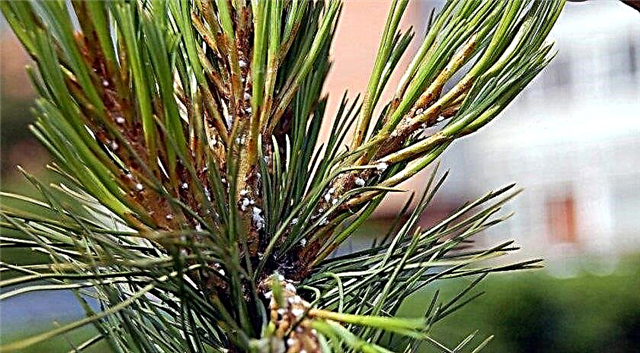
- Pine shield - This is a rather insidious insect that feeds on shoots and pine needles. It hides under the needles, so it is not always noticeable to beginner gardeners. If the pest is not destroyed, the pine will irreversibly dry up. In order to reanimate the plant and destroy the scab, it is necessary to use the “Antichrush” (10 ml per 10 l of water).
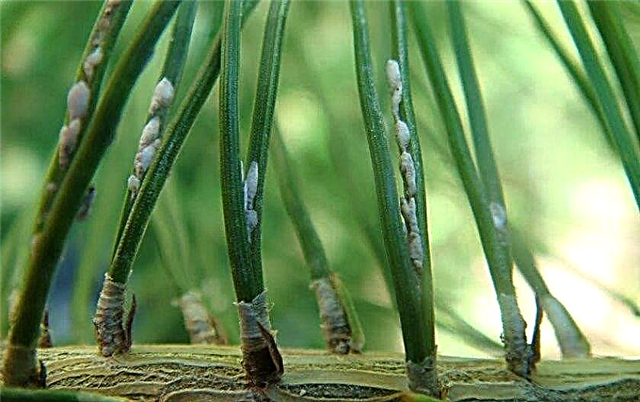
- Bed bugs - pests, which most often settle under the bark of pine and feed on its juices. Visually determine whether the pine tree is affected by these insects, by drying the needles on the tops of the branches. You can deal with sub-bed bugs with a hexachloran dust (20 g per 1 bush).

To prevent the appearance of pests on a pine shrub, you can spray it with a solution of Bordeaux fluid annually, as well as dig the area of the trunk circle.
To prepare the solution, it is necessary to dissolve copper sulfate (100 g per 1 l) and hydrated lime (150 g per 1 l of water) in separate metal containers in hot water. After that, the components are mixed with each other and add cold water until the volume of the mixture is 5 liters.
Important! Of most interest to bark beetles are recently transplanted young trees. That is why they must be additionally treated with prophylactic solutions.
If Winter Gold pine grows in low light conditions, high humidity, and is also weakened due to external interference (for example, improper pruning), then a fungus may begin to develop on it.
It can be recognized by the color change of the needles (the needles become black or brown), as well as by the appearance of a thin translucent web on the shoots.  It is necessary to cut off all infected shoots as soon as possible and burn them to prevent the further spread of the disease. The plant must be treated with a solution of colloidal sulfur (30 g per 10 liters of water).
It is necessary to cut off all infected shoots as soon as possible and burn them to prevent the further spread of the disease. The plant must be treated with a solution of colloidal sulfur (30 g per 10 liters of water).
A miniature pine will be an excellent landscape solution for gardeners who want to diversify their own plot. The plant has high indicators of frost resistance, it is undemanding to regular watering or bait. It is only necessary to plant a shrubby pine in a suitable place with enough sunlight, and the plant will delight with its original appearance for many years.





